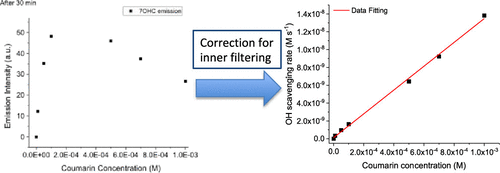当前位置:
X-MOL 学术
›
J. Phys. Chem. C
›
论文详情
Our official English website, www.x-mol.net, welcomes your
feedback! (Note: you will need to create a separate account there.)
Coumarin as a Quantitative Probe for Hydroxyl Radical Formation in Heterogeneous Photocatalysis
The Journal of Physical Chemistry C ( IF 3.3 ) Pub Date : 2019-03-07 , DOI: 10.1021/acs.jpcc.9b00337 Valentina Leandri 1 , James M. Gardner 1 , Mats Jonsson 1
The Journal of Physical Chemistry C ( IF 3.3 ) Pub Date : 2019-03-07 , DOI: 10.1021/acs.jpcc.9b00337 Valentina Leandri 1 , James M. Gardner 1 , Mats Jonsson 1
Affiliation

|
In this work, we have assessed coumarin as a quantitative probe for hydroxyl radical formation in heterogeneous photocatalysis. Upon reaction with the hydroxyl radical, coumarin produces several hydroxylated products, of which one, 7-OH-coumarin, is strongly fluorescent. The fluorescence emission is strongly affected by inner filtering due to the presence of coumarin. Therefore, we performed a series of calibration experiments to correct for the coumarin concentration. From the calibration experiments, we could verify that the inner-filtering effect can be attributed to the competing absorption of the fluorescence excitation light between coumarin and 7-OH-coumarin. Through judicious calibration for the inner-filtering effects, the corrected results for the photocatalytic system show that the rate of hydroxyl scavenging is constant with time for initial coumarin concentrations of ≥50 μM under the conditions of our experiments. The rate increases linearly with coumarin concentration, as expected from the Langmuir–Hinshelwood model. Within the coumarin concentration range used here, the photocatalyst surface does not become saturated. Given the fact that the highest coumarin concentration used (1 mM) in this work is quite close to the solubility limit, we conclude that coumarin cannot be used to assess the full photocatalytic capacity of the system, i.e., surface saturation is never reached. The rate of hydroxyl radical scavenging will, to a large extent, depend on the affinity to the surface, and it is therefore not advisable to use coumarin as a probe for photocatalytic efficiency when comparing different photocatalysts.
中文翻译:

香豆素作为多相光催化中羟基自由基形成的定量探针
在这项工作中,我们评估了香豆素作为异相光催化中羟基自由基形成的定量探针。与羟基自由基反应后,香豆素会产生几种羟基化产物,其中一种7-OH-香豆素具有强荧光性。由于香豆素的存在,荧光发射受到内部过滤的强烈影响。因此,我们进行了一系列校准实验以校正香豆素的浓度。从校准实验中,我们可以验证内部过滤效果可以归因于香豆素和7-OH-香豆素之间荧光激发光的竞争吸收。通过对内部过滤效果的明智校准,光催化系统的校正结果表明,在我们的实验条件下,初始香豆素浓度≥50μM时,羟基清除率随时间恒定。如Langmuir-Hinshelwood模型所预期的,该速率随香豆素浓度线性增加。在此处使用的香豆素浓度范围内,光催化剂表面不会变得饱和。考虑到在这项工作中使用的最高香豆素浓度(1 mM)非常接近溶解度极限,因此我们得出结论,香豆素不能用于评估系统的全部光催化能力,即从未达到表面饱和度。羟基自由基清除的速度在很大程度上取决于对表面的亲和力,
更新日期:2019-03-09
中文翻译:

香豆素作为多相光催化中羟基自由基形成的定量探针
在这项工作中,我们评估了香豆素作为异相光催化中羟基自由基形成的定量探针。与羟基自由基反应后,香豆素会产生几种羟基化产物,其中一种7-OH-香豆素具有强荧光性。由于香豆素的存在,荧光发射受到内部过滤的强烈影响。因此,我们进行了一系列校准实验以校正香豆素的浓度。从校准实验中,我们可以验证内部过滤效果可以归因于香豆素和7-OH-香豆素之间荧光激发光的竞争吸收。通过对内部过滤效果的明智校准,光催化系统的校正结果表明,在我们的实验条件下,初始香豆素浓度≥50μM时,羟基清除率随时间恒定。如Langmuir-Hinshelwood模型所预期的,该速率随香豆素浓度线性增加。在此处使用的香豆素浓度范围内,光催化剂表面不会变得饱和。考虑到在这项工作中使用的最高香豆素浓度(1 mM)非常接近溶解度极限,因此我们得出结论,香豆素不能用于评估系统的全部光催化能力,即从未达到表面饱和度。羟基自由基清除的速度在很大程度上取决于对表面的亲和力,


















































 京公网安备 11010802027423号
京公网安备 11010802027423号